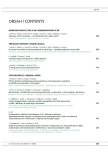An Analysis of a Set of Patients with Craniocerebral Injury Treated at the Pediatric Medicine Centre of the Teaching Hospital in Brno from 2000 to 2007
Authors:
E. Brichtová
Authors‘ workplace:
Klinika dětské chirurgie, ortopedie a traumatologie FN Brno
Published in:
Cesk Slov Neurol N 2008; 71/104(4): 466-471
Category:
Short Communication
Overview
The study analyses child patients treated for craniocerebral injuries from the point of view of the length of hospitalisation, neurologic symptomatology and the resulting clinical status one year post-injury. The set consisted of 346 child patients up to 18 years of age, treated at the Children’s Medical Centre of the Teaching Hospital in Brno from January 2000 to December 2007, and was divided into five age groups. The author recorded the etiology and the type of injury, and the percentage of polytraumas according to age and sex. The best recovery from a neurological deficit to normal condition was recorded in patients aged 2 to 14, the rate being over 50% of patients with a neurological deficit at admission. Good clinical result one year post-injury (GOS 5 and 4) was recorded in more than 80% of patients of all the age groups, except for the youngest children up to the age of two. Overall mortality in the set (10.4%) was at the lower limit of the range referred in relevant literature. The average time of hospitalisation at the Anesthesiological and Resuscitation Unit/ICU was longest in the youngest group up to two years of age (12 days), and shortest in the group of patients aged 7 to 14 years (6 days). The longest overall time of hospitalisation was recorded for the group of patients aged 15 to 18 years (24 days). The set of children with a craniocerebral injury included a higher proportion of girls than that referred in literature on the subject. Also mortality of girls corresponded to that of boys. In accordance with relevant literature, the resulting clinical status was good in more than 80% of patients.
Key words:
craniocerebral injury – child age – Glasgow Coma Scale – Glasgow Outcome Scale – neurological deficit – length of hospitalisation
Sources
1. Hayes HRM, Jackson RH. The incidence and prevention of head injuries. In: Johnson DA, Uttley D, Wyke MA (eds). Children’s head injury: Who Cares? London: Taylor and Francis 1989: 183–193.
2. Horowitz I, Costeff H, Sadan N, Abraham E, Geyer S, Najenson T. Childhood head injuries in Israel: epidemiology and outcome. Int Rehabil Med 1983; 5(1): 32–36.
3. Kraus JF, Black MA, Hessol N, Ley P, Rokaw W, Sullivan C et al. The incidence of acute brain injury and serious impairment in a defined population. Am J Epidemiol 1984; 119(2): 186–201.
4. Smrčka M et al (eds). Poranění mozku. Praha: Grada Publishing 2001.
5. Albright AL, Pollack IF, Adelson PD, Matsushima Y (eds). Principles and Practise of Pediatric Neurosurgery. New York: Thieme Medical Publishers 1999.
6. Cottrell JE, Smith DS (eds). Anesthesia and Neurosurgery. 3rd ed. St. Louis: C. V. Mosby 1994.
7. Bruce DA, Raphaely RC, Goldberg AI, Zimmerman RA, Bilaniuk LT, Schut L et al. The pathophysiology, treatment and outcome following severe head injury in children. Childs Brain 1979; 5(3): 174–191.
8. Náhlovský J et al (eds). Neurochirurgie. Praha: Galén 2006.
9. Frankowski RF, Annegers JF, Whitman S. The descriptive epidemiology of head trauma in the United States. In: Becker DP, Povlishock JT (eds). Central Nervous System Trauma Research Status Report. Bethesda, Md: National Institute of Neurological and Communicative Disorders and Stroke, NIH 1985; 33–44.
10. Adelson PD, Bratton SL, Carney NA, Chesnut RM, du Coudray HEM, Goldstein B et al. Guidelines for the acute medical management of severe traumatic brain injury in infants, children and adolescents. Chapter 14. The role of temperature control following severe pediatric traumatic brain injury. Pediatr Crit Care Med 2003; 4(3 Suppl): S53–S55.
Labels
Paediatric neurology Neurosurgery NeurologyArticle was published in
Czech and Slovak Neurology and Neurosurgery

2008 Issue 4
- Metamizole vs. Tramadol in Postoperative Analgesia
- Metamizole at a Glance and in Practice – Effective Non-Opioid Analgesic for All Ages
- Memantine in Dementia Therapy – Current Findings and Possible Future Applications
- Memantine Eases Daily Life for Patients and Caregivers
- Hope Awakens with Early Diagnosis of Parkinson's Disease Based on Skin Odor
Most read in this issue
- Carotid Artery Stenosis – Endarterectomy or Stenting?
- The Incidence of Epileptic Seizures and/ or Epileptiform EEG Abnormaliti es in Children with Childhood and Atypical Autism
- Drug- Induced Systemic Lupus Erythematodes in Interferon Beta-1b Therapy – a Case Report
- The Timing of Carotid Endarterectomy
